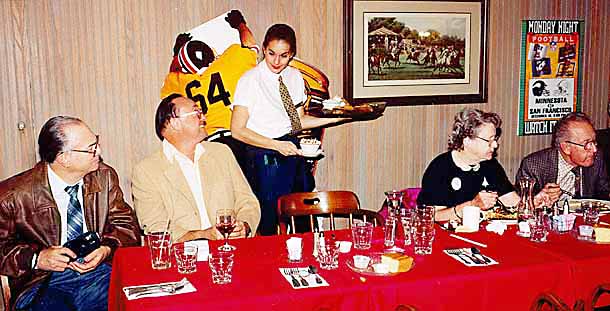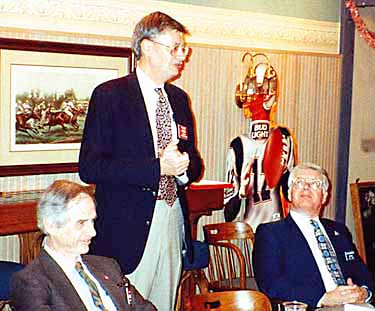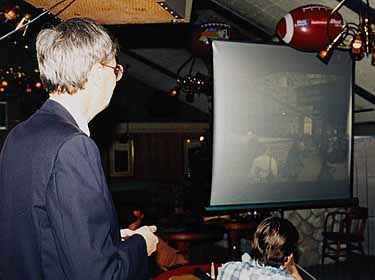
Contents
|
|
Meeting Notice
The next regular JPL Amateur Radio Club membership meeting will be held on Wednesday, January 10, at noon in 238-543. Club Board of Directors meetings are held at noon on the fourth Wednesday of each month in 301-227. Everyone is welcome at both meetings; bring your lunch. n
N6NOtes
By Merv
MacMedan, N6NO
Is Morse Code still useful? The Navy, Coast Guard and MARS have recently closed down their Morse code operations in favor of voice and digital modes that don't require special operator training. However, I understand some agencies (like the US Special Forces) still make use of it. There are still some circumstances where it's the ONLY way to get through.
I had an experience demonstrating this a few days ago when my office phone rang. I picked it up, but heard nothing. Hello? Hello? Nothing. As I was about to hang up, I heard what I thought was a beep. More beeps. Aha, long and short beeps! Morse code? Dahdidit didah dahdit didit dit didahdidit. "Daniel" - that's my son's name (N6HJZ). Now I knew something was up. Finally the phone went click and I heard nothing more so I hung up. Then it rang again. This time there was a recognizable voice (my son) who told me he was at Ontario Airport and was calling me from a phone bank. The microphone wires were broken on the first phone he had chosen, so he sent me the Morse Code message using the phone's touch tone pad. He called me the second time from another phone in which the handset worked. Mystery solved, and the code allowed me to identify who the call was from! The event made me proud when I realized that Dan hadn't forgotten that useful code he had learned (grumbling "why?" all the way) 15 years ago!
Best wishes to all our members for a most Happy New Year! n
On January 21, Merv, N6NO, goes on travel again, but this time it's on a personal scientific trip to the west coast of Costa Rica. He is joining an Earthwatch ecological project to help save the endangered Leatherback Sea Turtles that come on the beach to lay their eggs at this time of year. After they go back to sea it has been a mystery until recently where they migrate. Among other things, Merv will be helping the project to attach tiny VHF satellite transmitters to their backs to track their wanderings at sea, which seem to cover many thousands of miles.
Merv also plans to take a ham rig with him, but since he will be working at night starting shortly after sundown, his HF activity will be limited to daytime. Most activity is expected to be CW, but phone is a possibility. Recreational times are not yet known, so he will get in touch after he is set up and let someone in the club know his status. We hope to get the word out - in case any of you want to QSO - via the club's email exploder and Monday net. Possible dates of operation are January 23 - February 1. n
DX News
By Jay
Holladay, W6EJJ
N6ET is on vacation, so I agreed to pass along some DX tips this month. Since we are still at the bottom of the sunspot cycle, there may be days in a row when you will hear almost nothing above 20 meters. Then the solar flux will rise a few points above 70 and signals will start to be heard on 17 and 15 meters. Trans-equatorial openings will occur on 10 meters to places like Argentina and Brazil, and hope is renewed - conditions WILL get better!
So, check those WWV reports. Solar flux together with A and K index numbers are given at 18 minutes past every hour. Can't manage to be listening at the right minute? Then you need the DX packet cluster. A simple "SHow/Wwv" command will get you the last five WWV reports posted by users of the packet cluster. This is but one of the many services provided by the DX packet network. I've been connected to my local node (K6EXO in West Hills) almost continuously in the past year and it's a big help in keeping in touch with the DX scene. I'll be happy to provide more information on this DX-oriented network, if our readers are interested.
Here's a look at some current and planned DX operations, courtesy of The DX Bulletin and your guest conductor's occasional forays on the bands.
SOUTH ORKNEYS - LU6Z is available almost nightly on 7005 from 0200Z. The operators will sometimes QSY to 3505 later in the evening and have begun to show up on 17 meters. QSL LU6EF
MYANMAR - This formerly rare one (used to be known as Burma) is now allowing more ham activity. OH2BH and OH1NYP will operate again as XZ1A in January.
WAKE ISLAND - A KH9 operation is planned for Jan. 24-31 by AL7EL and others from the Dateline DX Association. Watch for them on all bands including the new bands.
VIETNAM - 3W5FM continues to come through around 1500Z near 7005. This is one of many Southeast Asian stations which are available most mornings on the low-end of 40, together with regular openings into Central Europe and the Middle East.
MACQUARIE ISLAND - VK0WH is now active on 7010 around 0930-1230Z. Warren's CW is a bit rusty after 15 years of inactivity, but have patience - it is possible to work this rare one.
That's all for this month - good luck in your DX endeavors! n
 |
|
President Merv MacMedan, N6NO, Opens the Meeting (photo by WB6TEB) |
Annual Banquet
Meeting
By Merv
MacMedan, N6NO and Jay
Holladay, W6EJJ
The club's Annual Banquet was held on December 13, the usual second-Wednesday-of-the-month, but in the evening. Some 28 people attended. The event was held in the upstairs banquet room at Marie Callender's Restaurant on Foothill Blvd. in Pasadena, where we enjoyed a delicious dinner in a private and quiet atmosphere. After the meal, President Merv MacMedan, N6NO, opened the meeting by saying that although there was a quorum present, this would be more of a social meeting, not a business meeting. That turned out to be fortuitous, because our trusty Secretary, George Morris, wasn't able to attend and take minutes!
 |
|
Some of the Crowd Enjoying the Annual Christmas Banquet (photo by WB6FX |
1996 Slate of Officers
In the absence of Stan Sander, N6MP (Nominating Committee chair), Merv announced that the committee had so far obtained candidates for the following 1996 positions:
Treasurer: Chuck Sarture, KG6NF
Secretary: Chris Zygielbaum, N6WEI
Vice President: Scott Nolte, N6CUV
Unfortunately, a candidate for President had not yet been determined, so the elections are being deferred until a complete slate is available.
Closed Repeater
Walt Diem announced that the 224.70 Kendecom repeater, which has had a history of being notoriously unreliable, had been removed that afternoon by Bill Wood and himself for Bill to perform an extensive overhaul on it. In its place was installed the old backup repeater (a classic, built by Bill about 15 years ago). For no-frills repeating, it should appear to work basically the same as the Kendecom, but the autopatch works a bit differently, so Walt distributed a new instruction sheet at the dinner to registered autopatch users. Registered autopatch members who were not at the dinner were sent copies by mail.
Group Construction Project
Merv relayed a proposal from Skip Reymann, W6PAJ, to make a group build of an all-band, automatic HF antenna tuner based on an article in January QST. It is microprocessor-controlled and does NOT require special connections to the transmitter (e.g., for controls like bandswitching). It is particularly good as a trunk-mounted mobile antenna tuner. The parts kit cost is about $150; the group would do the construction and assembly as a project, each participant getting a finished unit. Some 8 or 9 hands went up when Merv asked who would be interested, constituting a sufficient number to make the project do-able. You are encouraged to register your interest with Skip (Ext. 4-9465) by January 15 if you would like to participate in this group activity or if you have questions about it.
Key Rings
Next, Merv circulated a special offer from a key chain engraving company for engraved "license plate" key ring tags at a very good club price of $2.50. Some 16 key rings (with calls and names) were ordered by the banquet attendees.
KSC Apollo 11
Merv then reported that W6VIO had received its special Apollo 11 25th anniversary QSL certificate from Kennedy Space Center. Like the W6VIO Apollo QSL, the artwork was done by our friends at Goddard Space Flight Center (WA3NAN). Because KSC doesn't have a large organized club, the chief op Michael Hadley, KC4TCV, had to spend a kilobuck of his own money to print and mail the certificates. We know what KSC went through, don't we? But the effort was worthwhile because it makes a nice addition to one's collection of matching certificates from each of the NASA centers that participated in this event last year.
 |
Open House Appreciation
Nine certificates of appreciation from the Laboratory were presented by Merv to club members who staffed the Amateur Radio Club booth at last summer's JPL Open House. Those receiving the certificates were: Jon Adams, NW6H; Manny Caldera, KC6ZSY; Chris Carson, KE6ABQ (shown here); Rick Ebert, KE6ONX; M. L. MacMedan, N6NO; Rick McKinney, KA6DAN; Connie Morris, KA6JAM; George Morris, W6ABW; and Mark Schaefer, WB6CIA.
 |
Plaque For WB6RFR
For a number of years the club has been trying to get Dutch Schenck, WB6RFR, to our dinner meeting to receive a plaque in recognition of his tender loving care and housing of the club's 220-MHz Link Repeater at his home between 1978 and 1986. Dutch was again unable to attend, so this time Merv presented it to Dutch's longtime friend, Bill Wood, who will see that he gets it and that our thanks are properly conveyed. Photo by Mike Santana, WB6TEB

|
| Phineas Icenbice, W6BF, Presents ARRL 25-year Certificate to Merv MacMedan, N6NO, for the Club (photo by WB6FXJ) |
25-Year Affiliation
Phineas Icenbice, W6BF, ARRL Los Angeles Section Manager presented the club with an unexpected certificate honoring our 25-year affiliation with ARRL. As he presented it to Merv, he remarked that only about 10 clubs in his Section have been affiliated this long. Phineas then conducted a raffle (of sorts) giving one lucky member a printed copy of the latest ARRL Repeater Directory, while another got the electronic database version on a floppy disk.
 |
|
(photo by WB6TEB) |
DXCC Awards
Jay Holladay, W6EJJ (wearing his ARRL Vice-President hat), presented two ARRL DX Century Club awards to Bob Polansky, N6ET, for the club station, W6VIO. One award was for working 213 countries in mixed (phone/cw) mode, while the other was for 124 countries, phone-only. These tallys were also reported in January QST, page 88. Bob personally led much of the DX-stalking and QSL-card-digging (through the club's archives), while Rob Smith, N6JKQ prepared the application paperwork and handled the correspondence with ARRL Headquarters for the submittal. We are grateful to both for this achievement.
 |
|
(photo by WB6TEB) |
Mongolia Dxpedition
Jay Holladay then introduced the guest speaker, Art Goddard, W6XD, Vice Director of the Southwestern Division of ARRL . Art had just returned from a contesting expedition to Ulaan Baatar, Mongolia, where he and a group of world-traveling contesters operated as JT1Z in the CQ World Wide Phone Contest. Although propagation to the U.S. was not good (only a few hundred W/K QSOs) they tallied over 5,000 total contacts and the final score of ~4.7M points was a new record from Zone 23! His slides showing the logistics of the operation were as impressive as the slides of the people and countryside of this seldom-visited land, located between China and Russia.
 |
|
Art Goddard, W6XD, During His Slide Presentation (photo by WB6FXJ) |
Upon leaving at the end of the evening, several members remarked that it was the best club dinner meeting they had attended: good food, good atmosphere, good program. Many thanks to Warren Apel, K6GPK, for his excellent handling of the dinner prepayments and arrangements with the restaurant.
We hope you will all join us next year! n

|
| Christine, N6WEI, Winner of the ARRL Electronic Repeater Directory |
WB6IEA Repeater
By Walt
Diem, WA6PEA
The "backup" WB6IEA repeater/autopatch was installed on Wednesday, December 13, 1995, to enable extensive repair of the "new" Kendecom repeater. WB6IEA/R is operating on 224.70 MHz with a PL of 91.5 Hz. Several changes in the operation of this repeater should be noted.
The PL tone is now encoded on the repeater output. This is a significant advantage for those who are using modern radios with CTCSS (Tone Squelch) capability. Enabling Tone Squelch on your radio will eliminate your having to listen to other repeaters which are sharing the channel.
The repeater enables the use of DTMF paging by repeating Touch Tones from the left three columns of a keypad (0-9, *, #). However, the fourth column (A, B, C, or D) cannot be used for DTMF paging because the tones are muted. When the autopatch is in use, Touch Tones will be repeated on the telephone line but not on the repeater output.
Your attention is called to a common operating problem. Whenever the repeater has been idle, wait a couple of seconds after pressing PTT before you start talking. Without this delay, the first few words of your transmission or the call sign of the station you are calling will not be heard. The repeater has a built in pick-up delay when it has been idle and modern HT's using battery conservation add an additional pick-up delay.
Autopatch members need to be aware that the autodialer (Demon Dialer) currently is not working.
All members are encouraged to use the repeater and to join the autopatch. Although it is a private repeater for club members, members may tell their friends the PL frequency and invite their friends to use the repeater. The use of the autopatch is limited to autopatch members. If you have problems using the repeater or autopatch please let me know via email (diem@earthlink.net) or telephone (818-248-7525). n
ARRL
News
Provided by Jan
Tarsala, WB6VRN
Spartan
Packet Radio Experiment
By Ken McCaughey, N3FZX
The Spartan Packet Radio Experiment (SPRE) is an Amateur Radio (HAM radio) communications experiment. The primary mission is to test satellite tracking using amateur packet radio and the Global Positioning System (GPS). SPRE was developed and built by the University of Maryland Amateur Radio Association (UMARA) with assistance from NASA, volunteer engineers, and volunteer software professionals.
SPRE is one of four experiments on NASA's Spartan/OAST-Flyer spacecraft. The Spartan spacecraft is scheduled for launch on January 11, 1996 aboard the space shuttle Endeavour as part of mission STS-72. The spacecraft is a cube shaped, battery powered, retrievable satellite. Spartan will be deployed by the shuttle's robot arm and likewise retrieved after approximately 48 hours of free flight.
Mission Objectives: